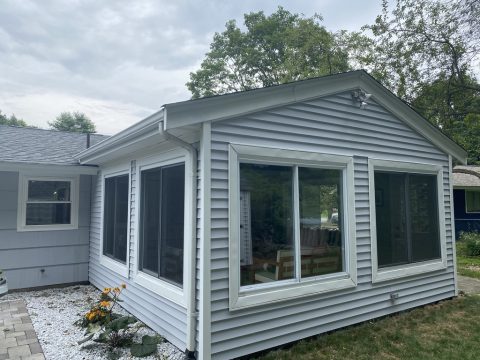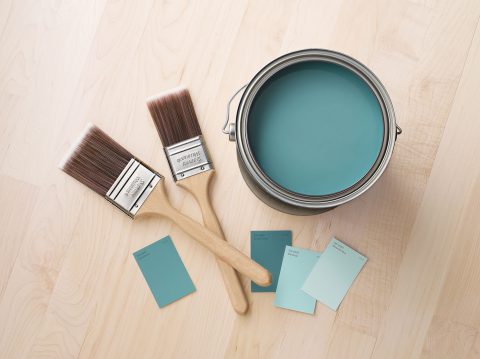
Painting Terms: Defined
Posted on October 13, 2020
Any time you have to interact with professionals from an unfamiliar industry – whether that’s painting, insurance, fine dining, or anything else – you’re going to encounter new language and terms specific to that industry. Every profession has its own jargon to wade through, and if you want to make sure you understand what services you’re buying, what work will be done, and what materials may be used, it’s a good idea to do some homework and get familiar with the industry lingo in question.
So, with that in mind, let’s take a look at some of the most common painting industry terms you’re likely to encounter.
Sheen

As discussed in a previous blog, paint sheen is the level of glossiness in each style of paint. This technology is what provides luster and shine, and also affects the overall durability. From highest sheen to lowest, the most common paint types are: semi-gloss, satin, eggshell, matte, and flat.
Some paint manufacturers may have other options between these types, but these are the styles you’re most likely to encounter.
VOC
VOC stands for “volatile organic compound.” As defined by the Environmental Protection Agency, VOCs are: “any compound of carbon, excluding carbon monoxide, carbon dioxide, carbonic acid, metallic carbides or carbonates, and ammonium carbonate, which participates in atmospheric photochemical reactions. This includes any such organic compound other than the following, which have been determined to have negligible photochemical reactivity: methane; ethane; etc.”
Related to the painting industry, VOCs are solvents that are released into the air as the paint dries. Paint technology continues to improve, and paint manufacturers are beholden to government VOC restrictions. Some paint makers opt to meet even more stringent guidelines, and any professional paint service you hire should be prepared to discuss VOC content with you.
Masking
In painting, masking is simply covering certain areas of a room or surface to protect them from being painted! This includes painters tape for edges, sheets of plastic for covering large areas, or even pieces of paper. The term applies to any technique that prevents paint from reaching a certain part of a given surface.
 Fascia
Fascia
Fascia, in terms of your home, are boards attached to the edges of the rafters – effectively the outside edge of the eaves. If you have gutters, they are most likely attached to the fascia. Vertical trim that runs from the ground to the roof and horizontal trim along rooflines can be referred to as fascia. Described another way, fascia is what connects your roof to the exterior walls of the house.
You’re likely to hear this term when discussing exterior painting because it’s particularly important to maintain – and particularly exposed to the elements.
Soffits
A relatively broad term, soffits are the visible underside of an overhang usually where the roof meets the siding of a home. Like fascia, exterior soffits are subject to weather damage, and can be a difficult area to paint effectively.
Spread Rate
Spread rate is an extremely simple concept: the square footage you can expect to cover per gallon of paint. Different types of paints have different spread rates, based on sheen, paint type, and the type of surface that’s being painted.
Professional paint services will calculate the amount of paint needed for a project by assessing the total square footage they need to cover, and the spread rate of the chosen paint.
Latex Paint
A common paint type, the term “latex” means that the paint is made with a synthetic latex binder. Sometimes called “rubber-based” paint, it’s easier to clean up with soap and water than some other paint types, such paint is no longer made with actual rubber – but the name (and the properties that make it popular) persists.
Acrylic Paint
Also named for its binder material, acrylic paint is made with an acrylic polymer as its binder. Acrylic paint is flexible and dries quickly, making it a popular choice for artists, and is used for certain situations in both interior and exterior painting.
Alkyd Paint
The modern version of “oil-based” paint, alkyd paint is again named for its binder. Alkyd paint is extremely durable, but less versatile than the other options. For this reason, professional painters usually opt for alkyd paint in special circumstances, like surfaces that require a higher degree of binding. You’re unlikely to see alkyd paint used on walls, but it still has a range of important uses!
Enamel Paint
Another particular type of paint, most often used on exterior surfaces that need serious durability, enamel paint dries with a glossy, extremely hard surface. While the term has evolved some over time, it most typically refers to oil/alkyd-based paint that dries with a hard, shiny finish. With modern technology, some water-based and latex paints also use the term to advertise gloss and hardness.
This one’s a bit loose, so be sure to ask your painters what they mean if they’re referring to “enamel” when selecting paints for your home.
Cutting In
“Cutting in” is a catch-all term for using a brush to create lines between two colors, work in tight spaces that rollers cannot, or do detailed work like painting ceiling lines, corners, along baseboards, and so on. True cutting in is done without tape or masking, and is a difficult skill to master.
Hide
Paint’s “hide” or “hiding power” is exactly what it sounds like: the ability to cover and conceal the color or old paint below. There are many factors at play here, including paint thickness, the color being covered, type of paint, and so on. A certain paint may advertise strong “hiding power” – but the other factors need to be taken into account as well.
Bleeding
The term “bleeding” in paint can refer to poor hiding power (see above) or trouble with the paint itself. It may simply mean that the coat of paint applied isn’t providing enough coverage, and that the old color is bleeding through – but more troublesome, it can also mean defective paint, where soluble dyes seep through the top coat color and produce reddish or yellowish stains.
Window Glazing
On older windows there is a putty-like material that helps keep the glass in place, adds to the aesthetics, and offers some weather protection. Over time this “glaze” dries out and cracks. The old material must be removed with a putty knife. The new putty is often rolled in one’s hands to make it more pliable and then applied like you would if you were applying joint compound to dry wall. It often takes a few passes before you get the smooth finish you want between the panes.
Window glazing is a labor-intensive process.
This is by no means an exhaustive list of all terms you’ll hear our professional painters use, but hopefully these definitions will help you better understand the ins and outs of professional painting services. For any questions about interior and exterior painting, the best options for your unique situation, and more, contact CertaPro Painters of Metrowest today at 781-296-6044, or fill out our online estimate scheduler for your free painting estimate.
Looking for more Home Exterior tips? Check out our other home improvement articles!





